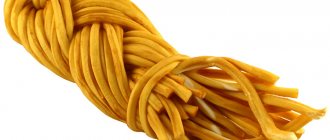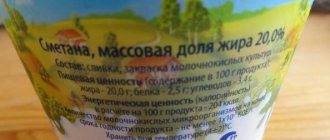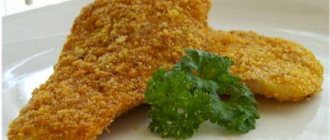Properties of bouillon cube
How much does a bouillon cube cost (average price for 1 piece)?
Moscow and Moscow region.
4 rub.
How delicious do the bouillon cubes look in the advertisements! A bright picture appears before us: fresh vegetables, a golden cube and aromatic steam over a plate of delicious soup. You just want to taste it, without thinking about what is actually revealed behind the colorful packaging of the small cube.
A bouillon cube is usually called pressed, concentrated and dehydrated vegetable or meat broth. Formed into small cubes (about 15 mm), this seasoning, in addition to broth, contains solid fat and additives, usually salt and monosodium glutamate. In the cubes that can most often be found on supermarket shelves, the content of monosodium glutamate is approximately one and a half grams, which is 65% of the permissible daily intake for a person of average weight (60 kg). The calorie content of a bouillon cube is 40 kcal per 100 grams of seasoning.
The main types of bouillon cubes, which can be purchased without problems in any store: beef, fish, chicken, mushroom, lamb, duck, shrimp and tomato.
Broth diet
Which, by the way, can always be verified by carefully studying the packaging. To understand that this is not worth doing, it is enough to remember that there are no vitamins and proteins necessary for recovery in the cube broth at all. But there is four times more salt than in the broth your mother prepares.
Consuming broth from cubes can also negatively affect the gastrointestinal tract, and according to some reports, even cause irritable bowel syndrome. Nutritionists will say that nothing particularly terrible will happen when adding bouillon cubes to dishes. Of course, provided that you do not exceed the recommended dose.
Products with monosodium glutamate are not suitable for regular nutrition; the norm is no more than two cubes per week. But, just in case, we will clarify that this applies to healthy people. You should not use cubes if you or your loved ones already have liver, kidney, or pancreas diseases.
They are also contraindicated for people with bronchial asthma.
Bouillon cube is a popular product. It can be added to soup, roast, used as a seasoning for meat or fish, and improve the taste of broth for dumplings. But is it as simple as it seems? These were dry cakes that were made for long military campaigns from beef, lamb or veal bones, egg whites and sea salt.
They are not recommended for use in baby food. The calorie content of a bouillon cube is on average 40 kcal per gram of product, whereas regular broth has kcal per gram. But you still shouldn’t include cubed broth in your diet.
This “semi-finished product” appeared in the 20th century, when people had less time to prepare food
Firstly, due to the increased salt content up to half the volume of the cube! Secondly, with frequent consumption of such foods, the sensitivity of your taste buds becomes dull.
And eating healthy food: cottage cheese, boiled meat, steamed vegetables will be much more difficult for you.
Thirdly, it is known that flavoring additives provoke appetite, which means it will be difficult to limit yourself to just broth. Debunking myths about bouillon cubes.
Benefits of bouillon cube
Of course, the benefits of a bouillon cube are evidenced by the fact that the cooking process becomes much easier and faster. Just one cube, added at the end of cooking to your favorite soup or hot dish, will enrich it with a golden color and unsurpassed aroma. But we should not forget that it is difficult for the body to get anything useful from such food, besides calories. Therefore, before using this, although aromatic, but not particularly healthy food additive, you should think carefully.
Currently, the topic of the benefits of a bouillon cube is very relevant, due to its not very useful composition. The broth cube owes its aromatic properties to the additive monosodium glutamate, which has the ability to increase the taste of the product.
Bouillon cube: composition, benefits and harm
The benefits of bouillon cubes are obvious: they significantly speed up cooking and give it a bright, intense taste. Unfortunately, there are no health benefits to speak of. Are bouillon cubes harmful? The answer to this question becomes obvious if we consider their composition. An ordinary store product (and it doesn’t matter what brand) is a mixture of preservatives, monosodium glutamate and artificial flavors. Salt is usually at the top of the list of ingredients, followed immediately by flavor enhancers. Then - sugar, hardened palm oil-based fat, flavorings and dyes, and only at the very end - trace amounts of dried vegetables and meat.
The harm of bouillon cubes is as follows. If you cook dishes with it often, an excess of ersatzes is formed in the body, that is, substances whose names begin with E. This, in turn, can lead to:
- weight gain;
- hormonal disorders;
- retinal damage.
- It is very likely that bouillon cubes also influence more frequent attacks of headaches and migraines.
Harm of bouillon cube
If you eat food every day, one of the ingredients of which is a bouillon cube, you can easily get gastritis, and sometimes even an ulcer. Doctors unanimously claim that such a “cocktail” of nutritional supplements is simply contraindicated for people with kidney and liver diseases, as well as pancreas. Gastroenterologists advise not to overindulge in such lunches, so as not to encounter the consequences and harm of a bouillon cube, and, if possible, take a thermos with a home-made lunch to work.
And bouillon cubes, or more precisely, monosodium glutamate in their composition, often cause addiction to the body, which is characteristic of narcotic substances. Therefore, before you throw a golden cube into a pan of food, think a thousand times about the possible consequences.
Homemade bouillon cube: recipe
If you value the convenience of cooking, but at the same time maintaining health, make this preparation yourself. It's very simple: prepare a good, rich broth from the chosen type of meat and/or vegetables. Then strain it and pour it into ice cube trays. You can sprinkle some dried vegetables and herbs on the bottom. Contrary to the first impression, this is not a burdensome undertaking, and such homemade broth preparations can be stored in the freezer for up to 3 months.
The composition of store-bought bouillon cubes is such that they do more harm than good. Therefore, you should not cook almost every second dish based on them, or even better, spend time creating homemade preparations that are much more friendly to the body.
Follow the most important and interesting things in the Tatmedia Telegram channel
What are bouillon cubes made from?
Videos in which a rosy-cheeked housewife pours steaming golden broth from cubes into plates or a famous chef pours the same cubes into a meat stew are designed to convince the audience of the naturalness and usefulness of the product for the whole family.
What are bouillon cubes made from?
But is it?
silicone food lid
Food Safety Guidelines
Food safety refers to good food preparation and storage practices to avoid foodborne illness. Food safety guidelines are essential to ensure customer health, extending the life of your food products. We recommend reading!
The time when bouillon cubes were made from natural meat is gone forever. Today, these concentrates contain more than a dozen different ingredients. The manufacturer reports that meat is included in their number, but the amount is insignificant. It is introduced into cubes in the form of meat powder
and gives the broth a taste and smell reminiscent of the natural aroma.
The bouillon cubes are based on vegetable protein extract, salt and starch.
. Starch is necessary to thicken the mixture and give the broth at least some “richness,” and the protein extract obtained from processing corn or soybeans increases the nutritional value of the product.
The flavor of the broth is provided by salt
and odious
monosodium glutamate
. Without the latter, the cubes would not have such a recognizable and pronounced taste.
Another component is vegetable fat.
. This name hides palm, sunflower, and corn oils - it is to them that we owe the thin film of fat on the surface of the bright yellow broth.
But the color of the finished product is given not only by fat, but also by the inclusion of dyes
- usually this is riboflavin, a common food coloring, also known as a B vitamin. Less often, the color of the cubes is given by sugar coloring - specially processed burnt sugar.
Look carefully at the ingredient list. It also includes dried chopped vegetables, spices
…
This is where the ingredients of natural origin end. Everything else is flavors (natural and identical to natural), antioxidants, and other additives.
Review: Natural Stock Cubes
Several years ago, there was a program on NTV in which it was said that in the USSR, bouillon cubes were made from natural products (in particular, from beef), but they were a curiosity, had an unpresentable appearance and did not sell well, since they were considered a “chemical”.
Today the situation is diametrically opposite: consumers are actively buying truly chemical cubes “with a taste identical to natural,” although advertising on TV is trying to convince us of their naturalness, showing a bunch of vegetables and even fresh meat, which supposedly contains the composition.
Are there any natural soup cubes? Oddly enough, yes, and our review proves it.
We tried three types of natural soup cubes: two from the German brand Bio Gourmet (beef and vegetable) and one from the French Jardin Bio (chicken).
How are they different from ordinary ones? Firstly, the fact that they do not contain monosodium glutamate, also known as a taste and smell enhancer, hiding under the name E621.
Secondly, the cubes contain dry chicken or beef powder, and not just chicken fish oil. And of course, vegetables (onions, carrots, celery, parsley, etc.), spices (turmeric, nutmeg), sea salt, starch and yeast extract.
And thirdly, Bio Gourmet cubes have the German eco-certificate BioSiegel nach EG-Öko-Verordnung (EU eco-regulation), and Jardin Bio - AB Agriculture Biologique of the certified body ECOCERT, which means that all the ingredients that are marked with an asterisk are grown with compliance with all requirements of environmentally friendly agriculture (which is 95% of the composition).
Jardin Bio Chicken cubes with herbs, 8 pcs. (200-220r.) Buy HERE
The peculiarity of Jardin Bio cubes is that they do not contain palm oil, but shea butter (karite) is used instead.
The cubes look familiar, although they are softer than usual, so they are difficult to use as a dry seasoning (you won’t be able to crumble them over a dish; you’ll have to pinch off the fatty crumbs and throw them into the soup).
I've used them as an extra seasoning for vegetable stews and added them to chicken noodle soup.
In vegetable stew, cubes enhance the taste of vegetables and spices; the dish turns out to be slightly different, with a more concentrated taste. The cube gives chicken soup a bright color and rich taste, so if you are not making broth from a whole chicken, then the cube will help you - the broth will turn out tastier than usual.
Ingredients: sea salt, shea butter *, corn starch *, brown cane sugar *, chicken meat (powder) * 4.2% yeast extract, chicken fat * 1%, celery *, onion *, spices *, herbs *, garlic*, natural flavor white wine vinegar*, natural flavor (egg).
* grown under environmental control
Bio Gourmet Bio Beef Broth cubes, 8 pcs. (RUR 215–RUR 281) Buy HERE or HERE
I added beef cubes to cabbage soup and borscht, and they act in exactly the same way as chicken cubes: they enhance the taste and aroma, and give additional strength to the broth. It is impossible to determine that a cube is used in the soup, and this is its main charm - it is simply a tasty and rich soup with seasonings. There is no unpleasant or dubious aftertaste.
Ingredients: Sea salt, starch*, palm oil*, yeast extract, beef powder (3.9%), raw cane sugar*, beef fat*(2.3%), tomatoes*, fried onions*, peppers*, garlic*, lovage leaves*, parsley*, marjoram*.
* grown under environmental control
Who invented the bouillon cube
Julius Maggi (1846−1912), the youngest son of an Italian immigrant, began his career at the age of 21 as an apprentice for a company that owned a steam mill in Budapest. Within two years, he rose to the rank of vice president, after which he decided to go into the family business, taking over the management of his father's mill in the Swiss city of Winterthur. For the next few years, the company teetered on the brink of bankruptcy, as more and more mills were opened in Europe and prices for their services were constantly falling. It was then that Julius realized that it was time to learn new activities. The idea was suggested to him by Fridolin Schuler, a Swiss doctor and labor inspector, who noticed the very meager diet of workers in numerous factories. Maggi set himself the ambitious task of creating a cheap, nutritious and reasonably tasty instant dish, although the combination of these qualities seemed impossible.
In his desire to create such a dish, Julius Maggi was far from the first. Back in 1831, the inventor of canned food, the Frenchman Nicolas Appert, proposed producing dehydrated broth in powder form, and in 1840, the famous German chemist Justus von Liebig developed his own technology for producing meat broth concentrate. But these products had a serious drawback - meat was used to prepare them, so the price of the final product was too high. Maggi decided to work on dishes based on legumes, which, unfortunately, take a long time to prepare and are much inferior in taste to meat.
Therefore, Maggi devoted almost two years of his life to culinary and chemical experiments, trying to find a way to improve the taste of ready-made dishes, and finally solved this problem in 1883. He subjected the starting products to acid hydrolysis of plant proteins (cooking in hydrochloric acid), obtaining, after neutralization, a mixture of amino acids, the main share of which was glutamic.
It is responsible for the “umami” (“meat”) taste, so the product was very reminiscent of meat broth... without using meat!
In 1886, instant soups were introduced first in Switzerland, and then in other European countries, where they became extremely popular. And in 1907, Maggi introduced his most iconic product to the market - the Maggi Kub bouillon cube, which made the name of the inventor world famous. And although since then the recipe has been improved several times, the shape of the cube, which nowadays can be bought in any store, has remained unchanged. The article “Taste in a cube” was published in the magazine “Popular Mechanics” (No. 12, December 2013).







